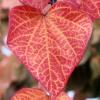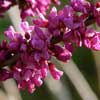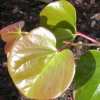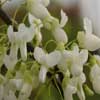 |
CERCIS canadensis
'Appalachian Red' The reddest flowers that I have seen in this genus. Although the flowers are an amazing colour, we find this one to be a much smaller, generally weaker plant. |
|
|
|
 |
CERCIS canadensis
'Flame'
Another recent selection, this one closer to the traditional colour. Yet the vigour and density of flower is far from normal. An amazing sight in full bloom. |
|
|
|
 |
CERCIS canadensis
'Forest Pansy' A wonderful introduction with deep purple heart shaped foliage which is so glossy that it looks almost artificial! Definitely in my top ten! Will make a rounded small tree. Flowers are produced following hot, sunny summers (so rarely in this country!) Consider them a bonus but by no means essential to the enjoyment of the plant. Wonderful translucent autumn tints, as illustrated in the photo left. |
|
|
|
 |
CERCIS canadensis
'Royal White' Pure white flowers. |
|
|
|
 |
CERCIS canadensis
'Rubye Atkinson' Coming Soon! |
|
|
|
 |
CERCIS chinensis
'Avondale' This recent introduction must be the most floriferous of all the Cercis. Masses of bright pink flowers clothe the stems in April. At that time, the stems are still bare of leaves as it is very late to come into leaf in the spring. This allows the flowers to be admired in all their glory. An unusual feature of Cercis is that the flowers are produced directly off the trunk and older branches, not just on younger wood. This means that they can be literally covered in flower to be a truly impressive sight. Very sturdy upright habit and slow growing by comparison with C. canadensis. Rich dark green heart shaped leaves. It will grow perfectly happily in a shady position, but will flower more freely in a sunny site with the benefit of good light and warmth. A major advantage of this species (and its cultivars) is that they are much more weather resilient, and seldom suffer storm damage. The root system is also more tolerant of our fundamentally wet climate, making this a much more robust and resilient grower, and a really good garden plant. We propagate all our clones of C. chinensis from cuttings so they are on their own roots. This enables them to develop their characteristic habit rather than being potentially influenced by a more vigorous rootstock. It also eliminates any possibility of unsightly graft unions and suckers, or incompatibility issues. Hence the plants will typically be multi-stemmed and bushy since that is how they naturally grow. Nevertheless, it is also possible to remove the lowest branches to create a more traditionally tree-like silhouette. As always, don't hesitate to discuss your requirements with me at the time of ordering, so I can personally select an appropriate shape to suit your preferences. See it in our Woodland Walk. |
|
|
|
| CERCIS
chinensis 'Don Egolf'
In 1984, seed was sent from cultivated plants in Yunnan, China to the US National Arboretum. Having observed the resultant plants for 5 years, one stood out as being slow-growing, compact, floriferous and sterile. It was eventually released in 2000, having been named in honour of the late Dr. Donald Egolf who was a highly regarded shrub breeder at the US National Arboretum. The twigs, branches and even the trunk will be clothed in bright red-pink flowers in early spring before the leaves. Where space is at a premium, this is the perfect small bushy tree for a hot, well-drained sunny site. |
|
|
|
|
| CERCIS
chinensis
'Shirobana' A white flowered selection. Not available yet, but we're working on it, so hopefully this will be coming soon! |
|
|
|
|
 |
CERCIS
reniformis 'Oklahoma' A fantastic recent selection with masses of dark pink, almost purple, flowers. Again, the same comments apply as for Avondale. The photo shows the rich bronze flushing through the young growth, as well as the glossiness of the heart-shaped leaves. |
|
|
|
 |
CERCIS reniformis
'Texas White' Essentially a white version of above, with the same other features. |
|
|
|
 |
CERCIS
siliquastrum 'White Swan' |